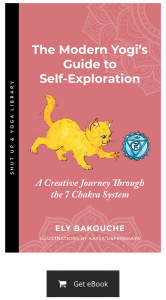Is yoga asana actually serving our bodies? As a modern-day human, is the physical practice of yoga still appropriate? My opinion: Yoga isn’t perfect. The mindfulness side of yoga is spot on, but the physical practice (aka asana) just does not fit with modern human anatomy. Before you go up in arms, hear me out.
Since we’re stepping into some controversial territory, allow me to establish some disclaimers:
- Yoga does not have to be perfect. Yoga does a lot of good for a lot of people. My intention here is simply to look critically at asana and consider ways in which we can improve the accessibility and performance of traditional yoga postures.
- The intention of yoga is not asana. The intention is to prepare the mind and body for meditation. This article is going to talk about how to better prepare for just that while also proposing a safer and more sustainable approach to asana.
- I’m not trying to demonize any style or lineage. Yoga is a sacred practice, and there are so many great interpretations of it. What I’ll be talking about pertains to each of them, but how you practice ultimately depends on what vibes with you, your body, and your mind.
- I’m mainly going to be referencing more vigorous styles of asana, but the concept and mindset can be applied to more gentle practices as well.

Meet people where they are at,
to take them where you want them to go.
In other words, let’s look at ourselves like the modern human we are before we try to force our bodies to do something that isn’t healthy for us.
The average person, before attending a yoga class, was:
- Sitting down throughout their day, including on their way to class.
- Overusing their wrists to text and type.
- Experiencing general neck and back pain associated with their job and lifestyle.
Too often, yoga asana assumes everyone enters the room in anatomic neutral, starts us in child pose, then WHAM, four poses later and apparently it’s time for wild thing.
Ask yourself:
- Did your last yoga class address your needs as a human being before guiding you into a yoga pose?
- Did it first address and neutralize the postural biases of your daily life before practicing bigger poses?
- Was there any kind of joint preparation or strength work to ensure your body would be comfortable and capable of sustaining more difficult postures?
- Did you practice or prepare for the action of entering the most complicated pose or performing the complicated transitions of vinyasa?

The questions above look into the human side of yoga. They address the anatomic and biomechanical demands that your yoga practice may impose upon your body. It also takes into account what your life is like outside your yoga mat. Movement is best when it comes with a sense of ease and fluidity, when it maintains the tensegrity networks and respects the natural movement of your joints!
Here’s the outline for this article:
Part I: Yogi Alignment vs. Human Alignment
Part II: Prep Yourself Before You Wreck Yourself
Part III: Pranayama, Ice Cream on top of the Human Breath Cake
Part IV: Human Yoga Sequencing
Part I: Yogi Alignment vs. Human Alignment

As a slender young male myself, it could be argued that many of the yoga postures today are designed for my body. But chances are, you look nothing like me or the boys in the image above, which is who a good portion of our yoga postures was designed for! Traditional yoga alignment simply was not intended for and is not suited for many of the bodies practicing yoga asana today.
The average yoga practitioner is a middle-aged female. Do you think they are going to feel, move, or have the same structural demands as the boys pictured above? HELL NO!
Many yoga postures are defended on the basis of the sacred history of the practice. In reality, most modern asana developed in the 1920s with Krishnamacharya at the Mysore Palace. Prior to this, there were other yoga postures, many to prepare the body for Lotus Pose so you could sit and meditate. I personally do not believe that a lot of modern folks have the ability (or even the need) to practice a full Lotus Pose.
What happens when we start assuming our bodies and students into shapes that do not adhere to individual alignment and structure?

The modern human body does not have one true alignment. Our bodies are dynamic, all alignment is good alignment (even occasional “bad alignment”).* It’s beneficial to train our body in a variety of ways so that our tissue is resilient.
*Bad alignment refers to what we may think of as a “misalignment” or a deviation from what traditional alignment dictates. Ex: Warrior II suggests that our knee needs to be stacked over our ankle, but if we never train our knee to move past the ankle, rotated inside the ankle, or externally rotated outside the ankle then we are never training these alignments should they occur in our lives off the mat. What happens when you don’t train a position? Your body is less likely to know and select the right options to protect itself!
I would like to propose 4 new tenets to Yoga Alignment:
- My alignment is different than your alignment.
- What feels good for me might not be great for you.
- If it doesn’t feel right, modify or skip the posture.
- The only bad posture is the one you spend too much time in or aren’t prepared for.
As you can glean from above, the new alignment is about options and variability. Instead of assuming a shape, we can set ourselves up for success by finding a comfortable and sustainable position.
Some of the most harmful cues we hear in class include:
“Push through the pain.”
“Breathe through the discomfort.”
But discomfort is relative. There’s “good discomfort” of a muscle holding tension (like holding High Plank), and there’s “bad discomfort” that refers to more of a painful/nagging/something’s-not-right feeling. This is an important distinction, and I’m referring to the latter here.
If there are teachers still telling you to do either of the above, they aren’t keeping your best interest in mind. They are blatantly telling you to ignore pain, the alarm system of your body! How can you possibly be practicing mindfulness if you are ignoring some of your body’s most important sensations?
If a teacher tells you to push through pain or discomfort:

Dog slap them with some knowledge! Or drop a cork block on their foot and ask them to push through that pain.
Part II: Prep Yourself Before You Wreck Yourself
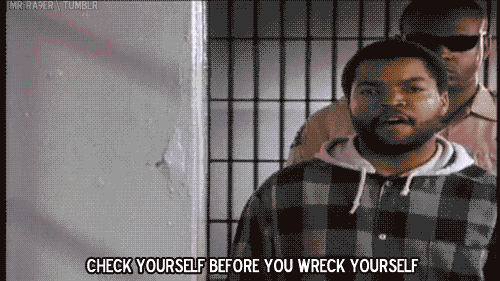
Perhaps my favorite thing to say in class, and also my spin on some great old school rap. Earlier, I discussed how people enter the yoga classroom not as the “anatomic neutral yogis” many of us teachers assume them to be, but as complex humans with complex physical histories.
Let’s just look at the fact that there is a high likelihood everyone was sitting prior to their yoga class.

How is this person prepared for yoga?!
- Shoulders are likely protracted and internally rotated.
- Spine has been flexed for who knows how long.
- Hips have also been flexed for far too long.
- Ankles and feet have likely been confined in shoes.
- Wrists are overworked from texting on phones or typing on a computer all day.
Recall the first part of this article: Meet people where they are at. Let’s see some examples:
– Starting class in a position that counterbalances the positions we were in throughout our day is much more effective than starting in a Child’s Pose. Starting on your back, standing, or prone are excellent and far more accessible. Child’s Pose requires a lot of ankle, hip, spine, & shoulder movement.
You’re probably catching on by now that I’m not a huge fan of starting class in Child’s pose.
– To prep ourselves the best, some kind of active joint mobility work or easy somatic movements can usually get our mind into our body and also aid our body in its performance throughout the rest of class.
I like to view this as distracting the mind with mindful movement. Sometimes it’s not easy to jump straight into stillness or breathing at the start of class. A little bit of preparatory movement can be a huge help getting yourself to focus more inward before you delve into the intricacies of pranayama & bigger yoga poses.
People rarely enter their yoga classes in a “neutral state.” Our bodies have been biased into a particular position all day (usually sitting) and now we expect our bodies to perform and move without preparation?
In meeting people where they are at, the very beginning of a yoga class should focus on return-to-neutral movements and postures. Help yourself establish neutral, THEN the real asana can begin!
When we sit, we are often flexed forward to some degree. So why not start with some extension or spinal movement like cat/cow. Laying on your back or lying prone for a few moments to establish breathing can be very profound in getting people prepared; it’s so simple, too!
One of my mentor clinicians told me: “Sometimes the best treatment we chiropractors can give is to give people an opportunity to lay on their back.” That statement forever changed the way I started my yoga classes.
I now always start people by simply having them lay on their back or stomach. Sometimes I’ll even start standing as that’s another great way to get people to move after sitting all day.
Meet people where they are at, to take them where you want them to go.
The second half of that statement is yoga asana, what you likely already know!
In many of the styles of yoga, floor spinal extension poses (like cobra, sphinx, etc.) are all practiced towards the end of class. I think this is SO BACKWARDS. Why would I want to end with extension? There’s enough flexion in yoga as it is, but another simple strategy to help people open up to neutral is do a few rounds of a lighter version of cobra at the beginning of your sequence.
Your back muscles are your antigravity muscles; you may be impressed by how well you feel and how your balance improves from this simple addition.
Starting class in Child’s Pose:

It’s also what you’ll say to potential pain/discomfort as you explore the new options available to your body with mindful preparatory movement!
Warming Up
In yoga, we still use a lot of stretching to help warm up. I’ll be blunt and say it: stretching is a terrible warm up.
Check out this systematic review on exercises and injury prevention:

This study looked at 25 trials, and the effect of physical activity exercises had on acute and overuse sports injuries. They found that multiple exposure programs, proprioceptive, & strength training produced the greatest effect in preventing sports injuries.
CONCLUSION:
Despite a few outlying studies, consistently favourable estimates were obtained for all injury prevention measures except for stretching. Strength training reduced sports injuries to less than 1/3 and overuse injuries could be almost halved.
The intention of a warm-up is to assess & prepare your body for movement. It’s very much about connecting to your own anatomy, perhaps assessing your current physical capabilities, and then ensuring you have the right Range of Motion (ROM) & muscle strength and coordination so that you can perform without a high risk of injury.
The only bad position is the one you are not prepared to perform.
– Dr. Andreo Spina
So what are you doing in the beginning of your class to address the mobility and strength needed for the postures your body is about to do?
Isometric and range of motion exercises can work wonders in preparing your body.
The easiest way to implement this is to stop asking, “What muscle do I need to stretch?” and start asking, “What joints do I need to prep?” For example, if I’m going to be doing a lot of groundwork, did I do anything to ensure an adequate amount of wrist extension?
Stretching does help with ROM by the way, but what is often missed is the strengthening that should follow it. If you open up the range of motion of the joint and then don’t use it or add some strength work in that new ROM, then you’ve wasted your time, and your body will return to its previous pre-stretched state. Bernie Clark put it perfectly: “If you stretch something, put a little strength there, if you strengthen something, add some stretch.”
Strength is also an important component of addressing our human needs. It’s a demonstration of control and a way that our body becomes more resilient over time. ROM without strength is pretty useless and can be dangerous.
Another important note: If you teach or take a class with a lot of transitions (like a vinyasa flow) or a class with a build up to a complicated posture (aka a peak pose), focus on the action of those transitions: How are you building the awareness, strength, mobility, and coordination needed for those actions?
Train the position you want to achieve; including how you get into and out of it!
My opinion: Yoga is a terrible warm-up for yoga. Stretching doesn’t do much to prepare your body, other than the fact that it feels good! There’s nothing wrong with doing something that feels good, and I still advocate stretching, just know its limitations, and please be intelligent when it comes to preparing your body for whatever you seek to achieve!
Here are a few more resources on this topic to prove I’m not some crazy man and also to reiterate the fact that you need to accent your yoga practice with alternative forms of movement!
- Strength training as superior, dose-dependent and safe prevention of acute and overuse sports injuries: a systematic review, qualitative analysis, and meta-analysis.
- Neuromuscular training for sports injury prevention: a systematic review.
- Exercise-based injury prevention in child and adolescent sport: a systematic review and meta-analysis.
Here are some more quotes that drive this concept home too:
The more control you have over your joints, the more control you have over your body.
The more control you have over your body, the more control you have over your movements.
The more control you have over your movements, the less likely your movements will falter.
If your movements falter less, then the less likely your chances of injury.
– Says the vast majority of science

Start at the beginning.
– Dr. Andreo Spina

A flexibility gain without stability imparted
may lead to pain once movement has started.
(Daily Maestroism #573)

Calling all limited motion problems a flexibility issue is problematic in that
it imparts the assumption that all can be helped with stretching.

Your warm-up, contrary to popular belief, is not designed to condition you and
it’s not to make you ‘supple’ and loose – looseness is the enemy of power.
– Stuart McGill & Brian Carroll (in the book Gift of Injury)

Lack of activity destroys the good condition of every human being,
while movement and methodical physical exercise save it and preserve it.
– Plato
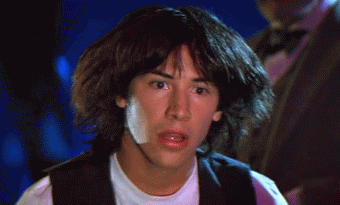
Part III: Pranayama, The Icing on the Human Breathing Cake
Ok, I admit it’s a disgusting title if you take it literally, but the metaphor is what matters here. Pranayama, like yoga asana, assumes people are breathing well prior to practicing it.
Human breath refers to 360-degree breathing, or the ability to expand your abdominal wall anteriorly, laterally, and posteriorly. Like a hula hoop around your belly button, your inhales should create an expansion of your whole torso.

This style of breathing is synonymous with your core and spinal stability. The three work together to create a cylinder in your torso. From this cylinder, you are much more prepared to move your arms and legs in some of the wilder shapes of yoga.
Check out how strong a cylinder is. The whole “inhale, puff your belly out” (like a beer belly) and “exhale belly to spine” messes up this whole alignment and compromises the integrity to your core!
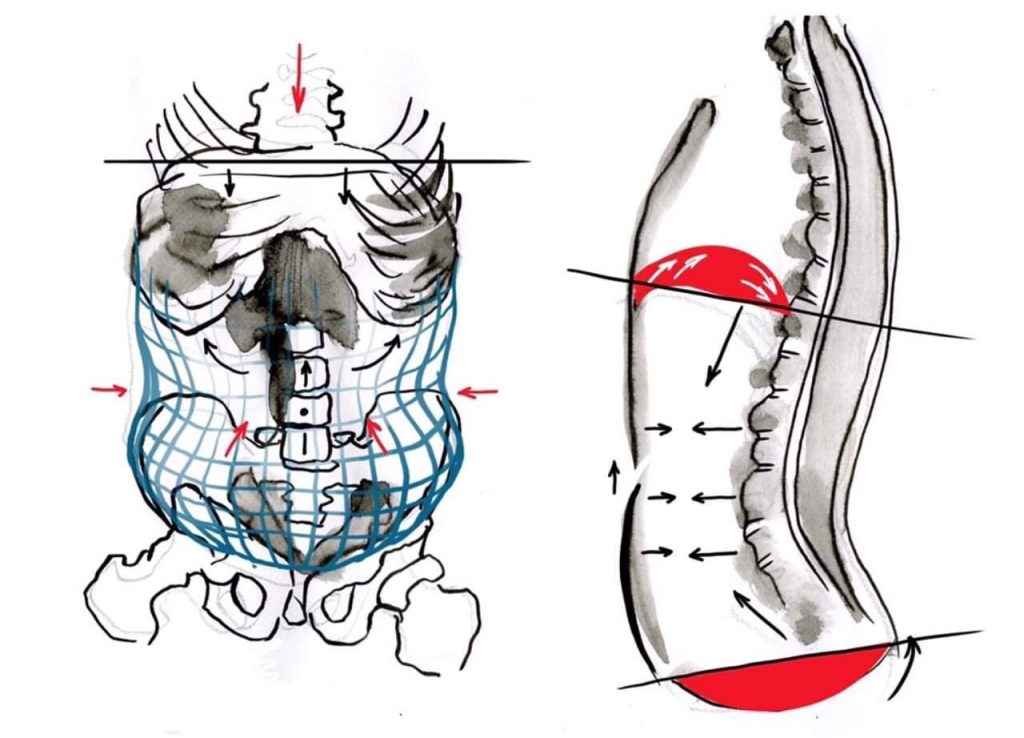
You can see from the images above what a “dent” to our core cylinder can do for the positioning of our rib cage relative to our pelvis. The image on the bottom demonstrates good IAP, Intra-abdominal Air Pressure. IAP refers to our ability to create outward pressure to withstand external pressure and maintain good position of our ribcage and pelvis to uphold against any load or demand imposed on our body.
“Exhale, belly to spine” can potentially affect the alignment of your rib cage over your pelvis.
Puffing your belly out often results in abdominal movement (rectus abdominis) and not true diaphragmatic motion.
Establishing some good human breath that is focused on the expansion of your abdominal wall should be a necessary prerequisite to pranayama. Stress often causes shallow breathing, and people to not use their abdominals to breathe. We have to learn to breathe properly before we can take it to the next level.
I don’t teach pranayama anymore; at least, not in group classes. You should breathe like a human first and foremost to get the maximum efficiency and stability to your core. THEN, once you are prepared to perform and benefit from it, the pranayama becomes the icing on top of the breathing cake!
I’ll very likely write more about this later, for now, you can try this to help the lateral and posterior expansion:
Breathing well is pretty amazing. If you breathe poorly, that is 23,000 things you are not doing well every day!

Part IV: Human Yoga Sequencing
I hope by now we’re on the same page and you can understand where I’m coming from. I know that yoga isn’t all about asana, but seeing as how asana is so common these days, I think that it is imperative we prepare ourselves properly before practicing.
Human first, Yogi Second
What were you doing before class?
How can you return to neutral before practicing traditional asana?
Looking more into returning to neutral, mobilizing joints, and implementing proper strength and breath can be a very powerful addition to your yoga practice. You may even find that it makes traditional yoga postures more accessible, improves balance, and creates a deeper sense of awareness and connection.
I’ll finish by providing some examples teachers, or home-practitioners can use to prepare better and protect their bodies:
- Vinyasa flow: Typically the B series in the sun salutation features some pretty big and complicated postures. What if you placed these more complex flows towards the end or middle of class so that you can better prepare for these actions? By the time you flow, wouldn’t it be nice if you had a level of familiarity with each posture so you can be mindful of the transition?
- Peak pose:
- Warrior III: “Cobra Pose in the sky.” You can start with some extension, and mini Cobra Pose to help create that feeling of lift. You can always work on hip and ankle mobility (great for any standing and balance pose) to better connect to your support leg.
- Handstand/Arm balances: Did you warm up the wrist and shoulders? Wrists need about 90 degrees of active extension and, for many arm balances, at least 120 degrees of shoulder flexion. Did you also implement strength exercises like standard push-ups to help distribute and support your weight throughout your arms?
There are so many different people practicing yoga these days. We cannot assume we are all ready for even the “basic poses” like child’s pose, let alone to hop right into a power flow! It is crucial to first view yogis as human beings so we can better prepare our bodies for asana.
At the end of the day, “Yoga is about doing a bunch of weird positions to better prepare for meditation.” (- Matthew Remski) I come from a mindset that we should be safe and sustainable in our practice to make the meditation all the more blissful!
I hope you enjoyed and learned something here. Please remember that there are always exceptions to this information and even though it may not serve you and your yoga community, there are definitely some humans who need to be addressed as humans before they assume yoga asana.
For more about being a Human, I’d highly recommend you check out the book Sapiens. It’s a fantastic history of our kind and gives a historical, philosophical, and cultural context to all this!
– DR YG
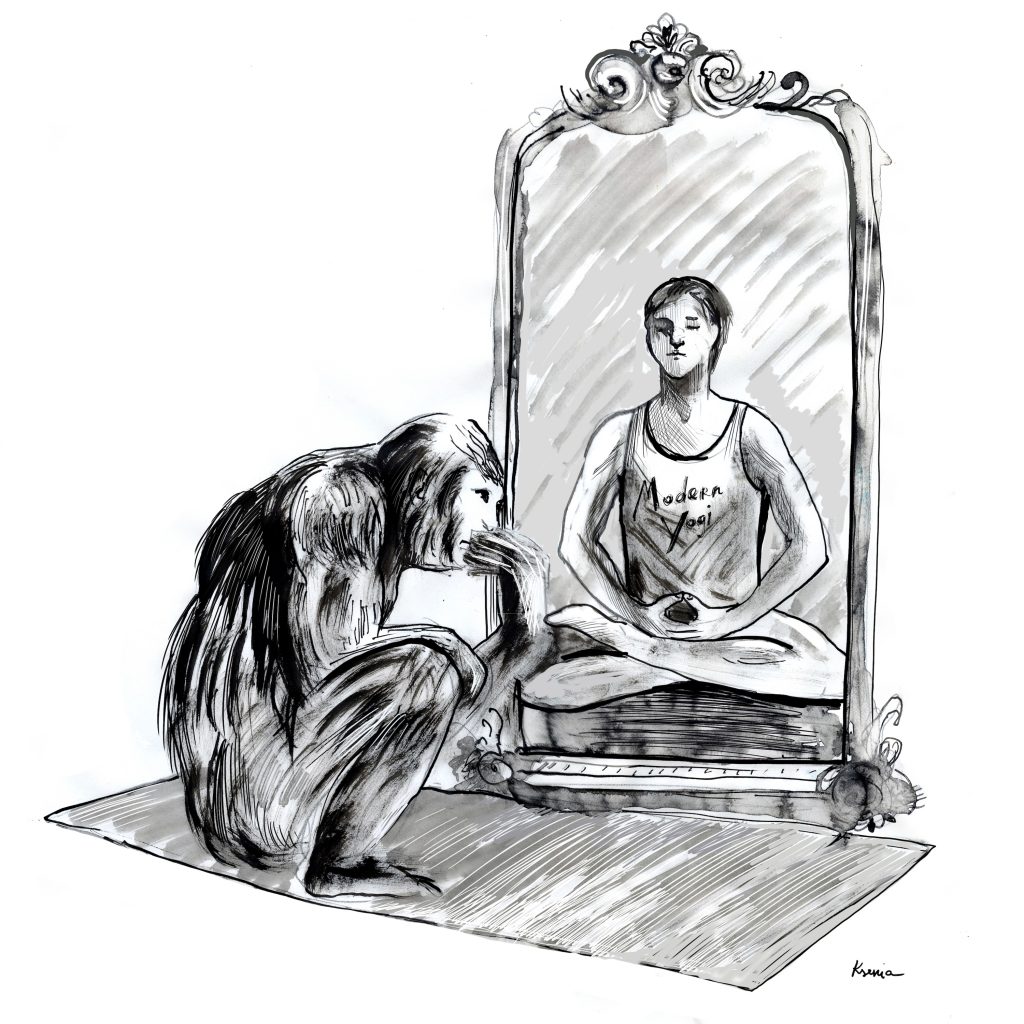
Illustrations by Ksenia Sapunkova
Edited by Sarah Dittmore
Enjoyed reading this article? Consider supporting us on Patreon or making a one-time donation. As little as $2 will allow us to publish many more amazing articles about yoga and mindfulness.





